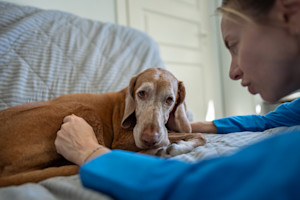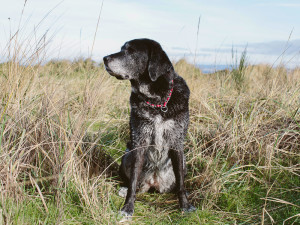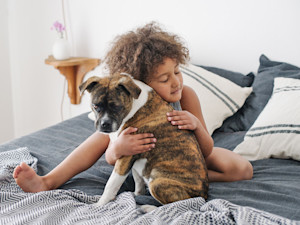Better a Month Too Early Than a Day Too Late
If the time is right, it’s OK if they’re still having ‘good’ days
Anyone who has a dog in their life will have thought about them dying, their lives are so much shorter than ours. It always makes me cry when I imagine life without my rescue dog Lucy. Tears are falling down my face as I write this; I’m curled up on my sofa, laptop balanced on my legs, Lucy beside me, her warm belly exposed.
But, here’s the thing that’s impossible to avoid: death is part of living. And euthanasia, deliberately choosing to end an animal’s life, is something we’ll probably all have to decide on, one day, for our dogs. Picking the exact ‘right’ moment is the hard bit.
Get (totally free) deals for food, treats, accessories, tech and way more pet parenting must-haves.
Lucy is my first dog, so I’ve never had to decide before. But my uncle Graham has, he always has a rescue Staffie by his side. Uncle Graham has recently been very ill and something he said on the phone has really stayed with me. “I don’t want to suffer, I’ve helped dogs end their lives and I want that dignity for myself, too.” And there’s beauty to be found in it. Something I hadn’t realised is that euthanasia literally means ‘good death’. It derives from two Greek wordsopens in new tab – eu (εὖ), meaning ‘good’ and thanatos (θάνατος), ‘death’.
Like any hopelessly devoted pet parent, I want to be prepared for it when Lucy‘s time comes. I want to make sure her death – like her life – is the best it can possibly be. So I started doing my homework. And a TikTok video by geriatric and palliative vet Dr Faith Banks helped me understand what setting a date for our dogs to die can mean for them – and for us…
How much do you spend on your pet per year?
End suffering versus prevent suffering
“Better a month too early than a day too late” is a term used in veterinary care, explains Dr Banks to me over Zoom. “It’s something we tell pet parents when it comes to how to tell when it’s time.” In veterinary school, Dr Banks was taught that euthanasia is a gift to “end suffering”, but she now believes it can actually be used as a tool to prevent suffering instead.
Working alongside your vet, you can make the decision to end your pet‘s life before it gets to the point where your heart is breaking for them. Before they are in so much pain that you’re not able to manage it. When they can’t get up to go to the toilet, when they can‘t make it to their food bowl unaided. “We, as vets, want you to know that’s OK,” she says. It’s OK to still go ahead if your dog wakes up on their last day having a ‘good day’. In fact, it can be kinder to let your dog go while they’re still having good days so that not every day is suffering and pain for them.
Caring for our dogs at the end
For 16 years, Dr Banks was a regular vet working in a general veterinary practice in Canada, but it was seeing her own dog ageing that got her interested in geriatric care. “I was witnessing all these changes in her,” she tells me from Toronto. “I was already a vet but I wanted to learn how best to help her and care for her.”
It was these feelings that led Dr Banks to open up her own mobile animal hospiceopens in new tab to help pet parents support their dogs through the later stage of their life. The majority of her work now is at-home euthanasia. “At home, their whole family can be present, including other pets. It’s a special and meaningful time for them all to be together when they say goodbye.”
Knowing when it’s time
When it comes to euthanasia, Dr Banks believes pet parents can struggle to make the decision because it’s not their own life. “They feel like they could make that decision for themself but because their pet can’t speak they feel they don’t have the authority somehow.”
But Dr Banks counters that, “you make every other decision for them, so this is a decision you should make – as long as you’re making it out of love and care for them,” she explains. “You decide what food your dog eats, how much, when and where; where they go; whether they’re neutered; where they sleep; when they go out to the bathroom.” Even on our walk this morning, I was thinking that I keep Lucy on a lead so she’s safe, I control her life in so many ways to ensure her happiness – and that way of looking at death feels sort of revelatory.
Quality of life
Dr Banks points me towards the quality of life scaleopens in new tab – where you can score your dog on everything from breathing, pain and energy to whether or not they’re still giving and receiving affection and the impact that’s having on you, too. “The questions are simple and you score from zero to five,” she explains. You can bring this with you to your dog’s appointments to discuss with your vet, especially if you have any questions or concerns.
Vets sometimes tell you that you’ll just know when it’s time, maybe you’ll share a look with your dog, for example. “That, to me, isn’t very helpful,” says Dr Banks. “If you have a chart that you can fill in – not just once, but use it regularly before your dog starts to decline, so you know what a normal baseline looks like. Then you have something to compare it to. Look at it month to month, see if there is a trend in the numbers.”
You live with your dog so you might not notice incremental changes. “It’s like when your hair grows,” says Dr Banks. “You don’t notice it but then you bump into someone six months from now and they say, ‘Wow your hair got so long’. And you didn’t even realise it. It’s the same when someone else sees your pet – including your vet.”
Rethinking death and dying
I always call on my friend Olivia when I want to think about things differently – especially when it comes to how you live. She’s full of the real talk I need to complement my neurotic soul. Olivia grew up surrounded by dogs. “And since I was really young, my parents taught me that helping them die is part of having a dog,” she says as she video calls from her sofa, a dog curled up next to her. “I’d be so unhappy without my dogs but with that comes responsibility.”
The date was set for Olivia’s dog Flea. But that morning, he woke up with a spring in his step, he was tottering around happily. Flea was 14 and had Cushing’s disease (an overproduction of the cortisol steroid hormoneopens in new tab), he’d been slowing down for a while and could no longer keep up with Olivia’s other two dogs, Buzz and Mouse.
One the day of his death, Olivia says that if she’d have said let’s go for a walk, he would have got up and gone with her. She had to ask the vet if they were doing the right thing. “Our vet hadn’t seen him in a while and noted the change in him.” He had a bit of life left in him, but Olivia didn’t want to see him deteriorate any more. “It’s almost like a privilege to be able to do this one final act for your dog. For a dog that you love so much, it’s a kindness,” she says.
And so, after discussing the decision with the vet, Olivia sat on the floor cradling Flea, chatting away to him as the vet injected him and he just went to sleep while she was holding him – “he was in his surroundings and completely chilled out,” she says. Olivia was so sad afterwards that she couldn’t look at photos of Flea but she’s not upset about the memory of him dying. “I just look back and think how lovely it was.”
Olivia questions, who are you keeping a dog alive for? Is it for them or for you? If they can’t move, it’s not like they sit and contemplate life or read a book or binge-watch a Netflix series. “We’re so detached from death in the modern world we remove ourselves from it,” she says, “but we shouldn’t.” And unless it’s temporary or after surgery, Olivia says she will never let any of her dogs get to the stage where they are wearing nappies. These are the decisions we should discuss openly with vets as part of our pets’ ongoing care plans
Prolonging the inevitable
And Olivia comes at the subject from a unique vantage point – she has multiple sclerosis, so she’s constantly in and out of hospital having treatments and taking drugs that will help her. Sometimes when she’s had chemo, she can feel horrific. “You hear of dogs having chemo, and I always think, how can you tell them that they’re going to feel really shit on this medication but they’re going to live longer… ?” she questions. “I know when I go through it, it’s temporary.”
Dr Banks also wants pet parents to truly think about what they expect when it comes to a “natural death”. This comes with a caveat, as she doesn’t want it to come across like she’s telling pet parents not to give medicine to their dogs – “but by doing these things, we’ve prolonged what natural death would have looked like for them. You’re prolonging what nature would have taken care of.” Your vet can help you understand the trajectory of your dog’s condition and what to realistically expect for them.
Coping with the ‘what ifs’
Perhaps it seems at odds with the way we view death in society – that we die when we’ve got no life left in us. But dogs aren’t human, “they don’t understand what’s happening, they live for the moment,” says Dr Banks.
“You can make yourself spiral a little with all the, what ifs? If you’re leaving a little life in them, maybe they could have lived another three weeks,” she says. “It’s possible, of course. And maybe those three weeks wouldn’t have been good – but we also know that very easily things could have changed.”
“Finding that time, before they truly suffer – I’m not talking a year ahead – but when you know what the disease is and what the decline might look like, why make them go through that?” she says.
And even though it’s a “good” day, it’s probably not a “great” day, says Dr Banks. Not compared to what life used to be like for them. Some pet parents find it helpful to make a promise to their dog about quality of life early on, when emotions aren’t clouding their judgement – it can sometimes make the decision easier when the time actually comes because they’ve already set some boundaries. “I once had a client who’d promised their dog ‘no bad days’” she says, meaning he’d prioritise his dog’s comfort and dignity over simply keeping him alive. So, when the time came, and after a lot of discussion, “he chose to euthanise a little early because he didn’t want to chance it.”
That kind of thoughtful planning can lead to the peaceful endings Dr Banks describes. “Not long ago, I did an euthanasia in a dog’s backyard,” continues Dr Banks. “The sun was shining and the dog spent all morning out there on a blanket eating treats. He was surrounded by his family. The dog enjoying it, the family all together. It wasn’t a stressful rush to the vets as an emergency. It was calm. They were so happy with how it happened.”
It’s these peaceful moments that Dr Banks hopes more pet parents can experience over trauma. Dr Banks gets lots of messages from people thanking her for making their dog’s death a beautiful experience – both for them and their pet. “I believe very strongly that when you have a more positive and gentle end-of-life experience with your pet that it helps with the grieving. If it was terrible and traumatic that stays with you. A gentle and loving experience is a proper goodbye. You know, after a good life, they had a good death. It makes a difference.”
And perhaps that’s the real gift we can give our dogs – not just a good life, but the dignity of a good death, too. Working hand in hand with a compassionate vet who knows your dog, you can make that final act of love as peaceful and meaningful as all the years that came before it.








